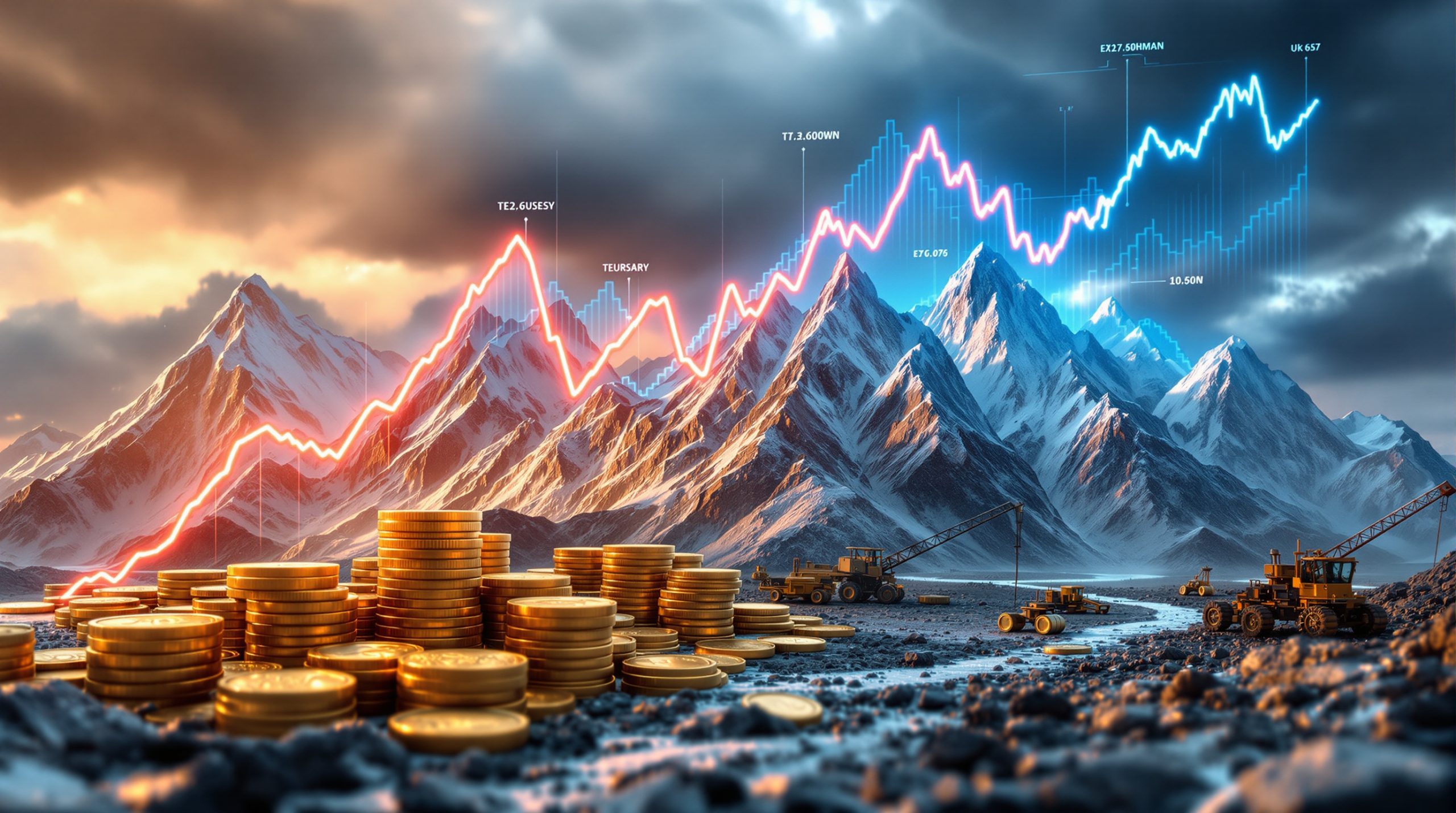Understanding Secondary Uranium Supply Chains: Impact on Market Dynamics
Secondary uranium supply represents all non-mining sources of uranium that contribute to global nuclear fuel supply. Unlike primary production from active mines, these sources include recycled materials, government and commercial inventories, underfeeding at enrichment facilities, and materials from decommissioned nuclear weapons. Historically, these sources have functioned as an invisible buffer in the uranium market, masking production deficits and providing flexibility during uranium market volatility.
Types of Secondary Uranium Sources
Secondary uranium supply can be categorized into several distinct streams:
- Government and utility stockpiles
- Recycled and reprocessed nuclear fuel
- Enrichment underfeeding and tails re-enrichment
- Former weapons material (highly enriched uranium downblending)
- Commercial inventories held by traders and financial investors
Each source has unique economic drivers, geopolitical considerations, and technical constraints that influence its availability and reliability in global markets.
How Have Secondary Sources Historically Influenced Uranium Markets?
The Cold War Legacy and Market Oversupply
For decades following the Cold War, secondary uranium sources dominated market dynamics. The massive stockpiles accumulated during the nuclear arms race flooded commercial markets when converted to civilian use. This oversupply fundamentally altered market behavior in several ways:
- Depressed uranium prices for extended periods
- Reduced incentives for exploration and new mine development
- Created a false sense of supply security among utilities
- Established a pattern of reliance on non-mining sources
The "Megatons to Megawatts" program, which converted Russian highly enriched uranium (HEU) from decommissioned nuclear weapons into commercial reactor fuel, exemplifies this dynamic. Between 1993 and 2013, this program alone supplied approximately 20% of U.S. reactor requirements, equivalent to roughly 24,000 tonnes of uranium.
From Buffer to Liability: The Changing Role of Secondary Supply
The reliable buffer of secondary supply has fundamentally transformed in recent years. What once functioned as a predictable surplus has become increasingly unpredictable due to:
- Depletion of Cold War stockpiles
- Strategic hoarding by governments and utilities
- Geopolitical tensions restricting access to flexible sources
- Financialization of uranium inventories
This transition matters because it removes the cushion that previously masked structural deficits in primary production. Utilities can no longer assume that secondary material will reliably bridge gaps between reactor demand and mine output.
What Is the Current State of Specified vs. Unspecified Secondary Supply?
Understanding the Critical Distinction
The uranium market distinguishes between two categories of secondary supply:
Specified Secondary Supply:
- Transparent, predictable sources with clear visibility
- Includes scheduled government sales, declared inventory releases
- Contributes approximately 5% of global demand
- Offers planning certainty for utilities and fuel buyers
Unspecified Secondary Supply:
- Opaque, variable sources with limited visibility
- Includes underfeeding, opportunistic inventory sales
- Highly responsive to price signals and geopolitical factors
- Creates market uncertainty and complicates long-term planning
The Geopolitical Reclassification of Flexible Sources
The Russia-Ukraine conflict has fundamentally altered the classification of many secondary sources. Materials that once provided reliable flexibility to Western utilities have shifted into the "unspecified" category marked by heightened uncertainty. This reclassification has forced utilities to reconsider contract strategies and diversify supply chains.
The U.S. Department of Energy holds approximately 3,194 tonnes of uranium in excess inventory, but this material is increasingly tied to domestic defense priorities and strategic reserve considerations, limiting commercial availability.
How Do Global Inventories Impact Market Dynamics?
Strategic vs. Commercial Inventories
Global uranium inventories totaled approximately 147,000 tonnes in 2024, but this headline figure obscures critical distinctions:
| Inventory Type | Approximate Volume | Market Mobility | Primary Holders |
|---|---|---|---|
| Strategic Reserves | 70,000+ tonnes | Very Low | China, U.S., France |
| Commercial Utility | 55,000 tonnes | Medium | Global utilities |
| Financial/Trader | 13,000 tonnes | High | Investment funds, traders |
| Pipeline Inventory | 9,000 tonnes | None | In-process material |
China's estimated inventory of 139,000 tonnes serves strategic energy security objectives rather than commercial purposes. True market-mobile supply available to Western utilities represents only a fraction of the total global inventory.
The Financialization of Uranium Inventories
Financial players including physical uranium funds and commodity traders have fundamentally altered inventory dynamics by shifting material into long-term storage. Unlike traditional utility inventories that function countercyclically (selling during high prices, buying during low), financial inventories behave procyclically:
- Rising prices trigger holding behavior, reducing market liquidity
- Price declines prompt selling, amplifying downward pressure
- Inventory becomes an investment asset rather than a consumption hedge
This transformation removes inventory from its traditional role as a market stabilizer and increases dependence on primary production to meet demand.
What Are the Technical Constraints on Recycling and Reprocessing?
Reprocessed Uranium (RepU) and Mixed Oxide (MOX) Fuel
Nuclear fuel recycling offers a theoretical pathway to supplement primary supply, but faces significant constraints:
- Only 96% of spent fuel material can be technically recovered
- Commercial reprocessing capacity is limited to a few facilities globally
- France's La Hague facility leads global capacity but serves primarily domestic needs
- Economic viability requires elevated uranium prices to justify processing costs
Mixed oxide (MOX) fuel, which combines plutonium with depleted uranium, faces additional challenges:
- Limited reactor compatibility (requires specific design modifications)
- Higher fabrication costs compared to conventional fuel
- Proliferation concerns limiting global adoption
- Strong environmental and political opposition in many Western countries
Underfeeding and Tails Re-enrichment
Global stockpiles of depleted uranium hexafluoride (DUF6) tails total approximately 2 million tonnes. Re-enrichment of these tails offers a theoretical supply source, but economic viability requires:
- Elevated spot uranium prices (typically above $75/lb)
- Access to low-cost enrichment capacity
- Favorable SWU (separative work unit) to uranium price ratios
Russia holds approximately 913,000 tonnes of tails, equivalent to roughly 41,000 tonnes of uranium, but geopolitical uncertainty restricts mobility of this material to Western markets.
The Department of Energy's Global Laser Enrichment (GLE) project, involving 200,000 tonnes of DUF6, represents potential domestic re-enrichment capacity but remains uncommercial until after 2030. This timeline gap creates a strategic opportunity for primary producers capable of delivering production before government-backed re-enrichment facilities come online.
Why Are Utilities Shifting Toward Primary Production?
The Jurisdictional Security Premium
As secondary supply becomes less reliable, utilities are increasingly valuing supply security over price. This shift manifests in several ways:
- Premium pricing for projects in stable jurisdictions (Canada, U.S., Australia)
- Earlier contracting in the development cycle to secure future production
- Longer contract terms to reduce exposure to spot market volatility
- Diversification of supply sources to mitigate geopolitical risk
Projects in Saskatchewan's Athabasca Basin, Wyoming's Powder River Basin, and Australia's Northern Territory have gained strategic value precisely because they offer stability that unspecified secondary sources cannot guarantee.
The Infrastructure Advantage
Capital efficiency in greenfield uranium development requires infrastructure advantages that reduce the proportion of capital allocated to non-productive assets. Projects with access to existing power, transportation, and processing infrastructure can achieve significantly lower capital intensity compared to remote developments.
Projects in established mining jurisdictions with existing nuclear fuel cycle infrastructure can achieve faster construction timelines and lower breakeven costs relative to projects requiring greenfield infrastructure investment.
How Do Production Economics Compare Across Supply Sources?
Cost Structure Comparison
The economics of various uranium supply sources vary significantly, creating a complex cost curve:
| Supply Source | Typical Cost Range ($/lb U3O8) | Price Sensitivity | Geopolitical Risk |
|---|---|---|---|
| ISR Production | $25-45 | Low | Variable |
| Conventional Mining | $35-60 | Medium | Variable |
| Inventory Sales | Variable | High | Low-Medium |
| Underfeeding | $40-70 | Very High | High |
| Tails Re-enrichment | $55-90 | Very High | High |
| Reprocessing | $70-120 | Medium | Medium |
In-situ recovery (ISR) operations typically demonstrate production costs in the bottom quartile of the global cost curve. This cost advantage provides operational resilience during periods of price volatility and allows these producers to capture margins even when secondary supply enters the market.
Operational Flexibility and Scaling
Primary producers with existing infrastructure and permitted capacity can respond to market signals through operational intensity rather than waiting for new projects to reach production. This flexibility allows established producers to capture value during short-term supply disruptions or price spikes that might otherwise be addressed by secondary sources.
What Does the Future Hold for Secondary Uranium Supply?
Structural Deficit Through 2040
Under reference scenarios from industry analysts, specified secondary supply will contribute approximately 5% of global uranium demand through 2040. Flexible sources exhibit high price sensitivity and geopolitical risk, creating a structural deficit that can only be reliably addressed through primary production.
The temporal dynamics of mine development create strategic value for projects that maintain optionality through extended market cycles. High-grade resources in proven geological environments can afford patient development timelines that align production with peak demand rather than forcing capital deployment during unfavorable market conditions.
The Consolidation Imperative
US uranium import ban policies have accelerated domestic consolidation as companies seek scale advantages in permitting, infrastructure access, and operational efficiency. This consolidation reflects industry recognition that fragmented junior developers cannot individually achieve the scale required to meaningfully offset secondary supply decline.
Innovation in Recycling Technologies
While traditional recycling faces economic and technical constraints, innovation in advanced recycling technologies could eventually supplement primary supply:
- Novel extraction processes for recovering uranium from tailings
- Advanced reprocessing techniques with improved economics
- Direct use of slightly enriched reprocessed uranium in certain reactor designs
- Small modular reactors designed specifically for recycled fuel
However, these innovations remain largely at the research or demonstration stage and are unlikely to meaningfully impact supply balances before 2035.
What Are the Investment Implications of Secondary Supply Decline?
The Uranium Investment Thesis
The structural decline of secondary supply and the geopolitical reclassification of flexible sources create a multi-year investment opportunity in primary uranium producers. Companies advancing projects with jurisdictional security, low-cost structures, and near-term production visibility are positioned to capture scarcity premiums as utilities lock in long-term contracts.
Key investment considerations include:
- Operational producers with uncommitted production capacity positioned to sell into strengthening markets
- ISR operators in stable jurisdictions with bottom-quartile cost structures
- Projects in jurisdictions unaffected by Russian import restrictions
- High-grade exploration projects with district-scale potential in established uranium provinces
- Companies with infrastructure advantages that reduce capital intensity and execution risk
Risk Factors to Monitor
While the secondary supply decline creates favorable conditions for primary producers, several risk factors could alter this trajectory:
- Accelerated development of domestic enrichment and recycling capacity
- Strategic inventory releases by governments to suppress prices
- Technological breakthroughs in advanced recycling economics
- Demand destruction from reactor closures or construction delays
- Policy shifts affecting nuclear fuel cycle regulations such as the Nova Scotia uranium ban
A Market Repriced Around Primary Mining
The invisible buffer of secondary supply has become increasingly unreliable. Inventories have shifted from mobile commercial stock to strategic reserves. Re-enrichment capacity remains constrained by economics and geopolitics. Recycling faces technical and political limitations that prevent scalability.
This transformation ensures a sustained rerating of uranium assets and a scarcity premium across the cost curve. Companies with jurisdictional security, execution capability, and near-term production catalysts are positioned to capture valuations reflecting their role as the only predictable source of uranium supply in a market where secondary buffers have disappeared.
The transition from invisible buffer to structural liability marks a fundamental shift in uranium market dynamics, one that rewards primary production and penalizes dependence on sources that can no longer be relied upon for long-term fuel security.
FAQ: Secondary Uranium Supply Chains
Why can't secondary uranium supply sources meet current demand?
Secondary sources including government inventories, HEU downblending, and commercial stockpiles have declined to approximately 5% of global demand through 2040. The majority of remaining inventories serve strategic rather than commercial purposes. Geopolitical restrictions on Russian enrichment services and technical limitations on recycling further constrain accessible secondary supply.
What is the difference between specified and unspecified secondary uranium supply?
Specified secondary supply includes transparent, government-declared sources such as scheduled inventory releases and disclosed excess inventories. Unspecified supply encompasses flexible but unpredictable sources including underfeeding, tails re-enrichment, and opportunistic inventory sales that respond to price signals and geopolitical conditions rather than contractual commitments.
How does the Russia-Ukraine conflict affect uranium supply chains?
The conflict shifted enrichment flows and tails re-enrichment capacity from predictable flexible sources into geopolitically contingent categories. Western utilities cannot rely on Russian-sourced material for long-term fuel planning due to sanction risks and jurisdictional uncertainty, forcing diversification toward primary producers in stable jurisdictions.
Why are ISR operations in stable jurisdictions strategically important?
ISR operators demonstrate production costs in the bottom quartile of the global cost curve. These operations can scale rapidly through drilling efficiency improvements and provide supply before advanced recycling or re-enrichment capacity becomes commercial, addressing the gap between growing reactor demand and constrained primary production capacity.
What creates the scarcity premium for Tier-1 uranium assets?
Jurisdictional security in politically stable regions combined with execution capability, infrastructure advantages, and near-term production timelines create scarcity premiums. High-grade deposits provide natural hedges against cost inflation while established infrastructure reduces capital intensity. These factors position Tier-1 assets as the only predictable uranium source as secondary buffers disappear.
Further Exploration
Readers interested in learning more about secondary uranium supply chains can also explore related educational content from Crux Investor, which offers additional perspectives on uranium market dynamics and supply-demand fundamentals. Furthermore, the Patterson uranium project illustrates how exploration companies are responding to uranium mining disruption by developing new sources to address the growing gap between supply and demand.
Want to Catch the Next Major ASX Mineral Discovery?
Stay ahead of the market with Discovery Alert's proprietary Discovery IQ model, providing instant notifications when significant mineral discoveries are announced on the ASX. Explore historic returns of major discoveries and how they've transformed companies by visiting Discovery Alert's dedicated discoveries page.




